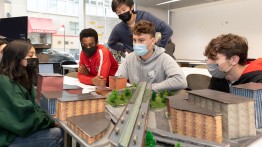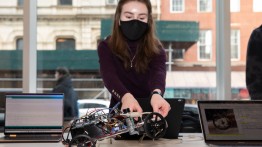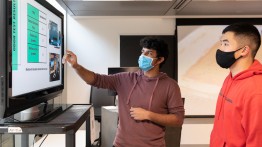First-year Engineering Students Showcase Final Projects
POSTED ON: December 20, 2021
As the Fall 2021 semester wound down last week, every first-year Albert Nerken School of Engineering student participated in the first of what might be considered a miniature End of Year Show. Taking over several floors of classrooms in 41 Cooper Square, this fall’s class of 140 students presented over 35 final projects that resulted from their work as part of Engineering Design and Problem Solving (EID-101).
“I am delighted that the faculty put on this event as this format is a great way for students to present their work to a range of audiences: students, staff, faculty, and visitors, which is an important communication skill for engineers,” says Lisa A. Shay, associate dean for educational innovation, Albert Nerken School of Engineering, who oversees the first-year design course. “The experience also prepares students for their future senior year capstone projects, most of which have similar poster presentations.”
A program requirement for all engineering majors, EID101 provides a hands-on immersive, interdisciplinary experience that explicitly teaches design thinking and problem solving. Taught by five faculty from across the school of engineering (Cynthia Lee, Michelle Rosen, Neveen Shlayan, Amanda Simson, and Elizabeth Waters) and one from architecture (Austin Wade-Smith), the course also gives first-years an opportunity to experience collaborative group work as they work together in teams to solve a problem of their choice. Projects this fall varied from exploring several closed-loop systems to enhance the livability of cities to designing interactive and educational neuroscience toys.
"I taught a section on Critical Infrastructure Resilience in NYC, and was surprised—and thrilled—at how many of my students took it upon themselves to reach out to local professionals and experts to talk with them about their topics and projects," says Cynthia Lee, assistant professor of civil engineering. "We had engineering consultants, MTA employees, and other professors and researchers involved in our section projects this fall, and the students learned so much in terms of professional communication, writing, and research. Some students in my section expressed interest in continuing their projects, and that motivation to keep learning and designing in engineering is such an important part of what EID101 is all about."
Other topics included Re-envisioning Waste that challenged students to prototype solutions for a specific waste stream, like fast fashion; Bioinspired Design that considered how to use nature’s best designs to improve urban design; and Hydroponics that explored urban agriculture to engineer a more secure and just ecological future.







